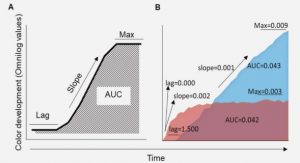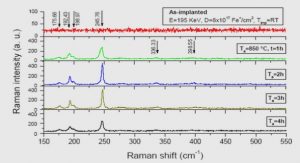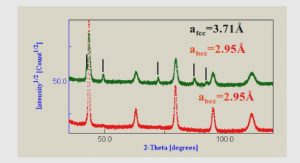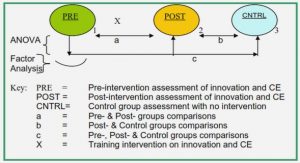Get Complete Project Material File(s) Now! »
Chapter 3. Nutritional influences on Crohn’s disease
This chapter describes nutritional factors that can have an impact on people with CD. These factors include their nutritional status, gene-nutrient interactions, beliefs and behaviours, food intolerances, and foods and nutrients associated with reducing inflammation.
Nutrient deficiencies and Crohn’s disease
Nutrition for people generally embodies the concept of nourishment and the ingestion of food and drinks that provide energy and promote the growth and maintenance of the body (550). Assessment of people with CD often shows they are under weight, with specific vitamin and mineral imbalances and this contributes to their ill health (66, 67, 551-554).
Three studies illustrate this (Table 3.1). Vagianos et al. collected dietary information by questionnaires including dietary supplements and observed multiple and clinically significant vitamin and mineral deficiencies in adults with CD attending a gastroenterology outpatient clinic (66). Inadequate reported intake was defined as <66% of the dietary reference intake (RFI) for each micronutrient. Stein and Bott (2008) report on nutrient deficiencies on hospitalised adults with CD (67). Hartman et al. in 2016 (555) investigated the nutritional status of children and adolescents with IBD who were ambulatory outpatients (57 with CD and 11 with UC) at a gastroenterology clinic. They reported the median nutrient intake percentage compared with the Required Daily Allowance (RDA) and dietary intake of healthy children. The intake was considered low if less than 80% of RDA.
All three studies showed low levels of vitamin A and D and folate in people with CD. Stein and Bott (67) and Hartman et al. (555) both found substantial risk for deficiencies of magnesium, zinc and iron (Table 3.1). Stein and Bott (67) also showed lower B12 concentrations for inpatients and Vagianos et al. commented that in those with CD (compared to those with UC) had lower B12 concentrations with their serum biomarkers. Also among men with CD, there were a significantly higher proportion who had haemoglobin below the normal range compared to men with UC. Hartman et al. report anaemia was the most common sign of nutrient deficiency in their adolescents (51%).
For people with CD, malnutrition may also occur because of the severity of oral lesions experienced which results in difficulties with tasting, chewing and swallowing. This means some foods are avoided e.g. tomatoes because of their perceived acidity. Oral involvement in CD has been identified as occurring in 8-29% of people with this disease (556). Examples of oral symptoms include: labial swelling, which also may include the gingiva and mucosa, mucosal polyps, cracking at the edges of the lips (angular cheilitis), ulcers, fissures and granulomas (557, 558). The mucous membranes in the mouth normally have a rapid cell turnover of 3-7 days in contrast to the skin which is up to 28 days (559). Loss of cells but not replacement can lead to the mouth showing early signs of systemic disease and early predisposition to nutritional deficiency. It is becoming increasingly recognised by those caring for the oral cavity of people experiencing CD that oral lesions may be the first indicator of CD and may precede bowel symptoms (272). The commensal and pathological bacteria already present in the mouth may also exacerbate damage to the mucous membranes. In CD, the oral cavity shows a higher prevalence of the bacteria Streptococcus mutans and Lactobacilli which are associated with tooth decay (376, 560). In addition, eating, drinking, oral hygiene and breathing can also disturb already weakened membranes (561) and exacerbate the problem.
In a study on the perceived oral health (n= 1943) on people with CD, Rikardsson et al. (2009) (562) showed that people with CD thought their oral health was worse and that they had more need for dental treatment than those in the control group of 1,000 people.
Many vitamins and minerals are considered necessary for healthy mucous membranes (Table 3.2) (561). A number of these essential nutrients are low in people with CD as illustrated in Table 3.1 (66, 67, 555). These nutrient deficiencies, and a higher presence of bacteria associated with dental caries, would undoubtedly contribute to the oral symptoms experienced by people with CD.
Nutrition deficiencies associated with diet ‘Westernisation’
Another diet related factor often discussed is the change of diet associated with increasing ‘Westernisation’ and aging of populations. The incidence of CD has been increasing (563-566). This has often been related to today’s Western diet which has changed substantially in the last seven decades (125, 567-572). This is because of changes in food production and technology which provides easy access of urban based populations to cheap food high in sugar, refined oils and grains (573). In Bangladesh for example the incidence of diagnosed IBD is very low. However, when individuals have moved to the United Kingdom (UK) where they are more highly exposed to western culture and food choices, the incidence of IBD increases substantially within a generation (574) but this may also be that they receive better health care.
The risk of CD appears to increase as the diet becomes more westernised and processed. This may be related to the refinement of “Western” food containing less fibre. Current intakes associated with the Western diet are assessed to be about 20 g/day, compared to a fibre content of 70-120 g/day when diets rich in fruit, vegetables and grains are consumed, as is estimated for hunter-gathers and agriculturalists in human history (575). The low consumption of fruit, vegetables and dietary fibre and the increased intake of refined sugars and animal fat have been observed in people with CD
(576), as are exclusion diets for IBD made popular in the media (577). The risk of IBD has been negatively associated with the intake of fibre (127, 568, 578). Fibre is categorised into two groups: insoluble and soluble. The removal of insoluble fibre, a component of skins of fruit and vegetables, whole grains, and seeds, is a current recommendation by the Crohn’s and Colitis Foundation of America (579) when people are experiencing a flare because insoluble fibre may intensify bloating, pain, diarrhoea and gas. However, the consumption of soluble fibre in vegetables (e.g. the brassica family, dried peas and beans, parsnips, carrots, potatoes, spinach, squash, zucchini) and fruit (e.g. pip and stone fruit, berries, bananas, dates, cantaloupe, grapes and pineapple), oat cereals and barley is recommended. Soluble fibre promotes water absorption, enabling the gut contents to form a gel-like consistency, which delays emptying of the gut and reducing diarrhoea (579). Soluble fibre also provides a substrate for bacterial fermentation in the colon (16). The soluble plant fibres in plantain and broccoli reduce the movement of E. coli across M cells in Peyer’s patches (580). In CD, E. coli is found in increased numbers in the mucosa (355, 356). Lack of soluble fibre in the diet may contribute to the pathogenesis of CD.
Some authors believe that the Western diet has become pro-inflammatory as a result of the increased consumption of saturated fatty acids and less unsaturated fat. In particular the decrease in the ratio of the omega-3 and omega-6 PUFAs ingested partly because of less consumption of fish. In earlier times, people consumed only small amounts of these PUFAs and in about the same proportion. Today it is estimated that this ratio is now about 1:16 omega-3 to omega-6. This has occurred from the increased intake of vegetable oils (e.g. soy, safflower, corn and sunflower) (213, 581, 582).
Another hypothesis is that the rising use of sugar substitutes during this time has contributed to the rise in CD (583). A number of studies have been conducted on the effects of artificial sweeteners (AS) on the gut. These have looked at their effects on secretion, absorption, gut motility, the microbiome and gastrointestinal symptoms (584-588). Some studies imply AS have measurable effects on the oral/gut microbiota (583, 589, 590). In one example, male rats were randomised into control and AS groups and were exposed to doses ranging from 1.1 to 11mg/kg/day) for 12 weeks. (The USA Federal Drug Administration – FDA- acceptable daily intake for humans is 5 mg/kg/day). At the low dose of 1.1mg/kg the researchers reported total anaerobes were reduced by approximately 50% in all sucralose plus maltodextrin groups. However, when this study was reviewed by an expert panel (591), the study was criticised for not having an isocaloric carbohydrate control and not correcting for the water content of the stools. Both these factors can affect the interpretation of the bacterial concentrations. This report also commented that the difference between control and treatment groups for bacterial counts given were also less than 10-fold. They concluded that this meant that the results could not be interpreted as indicative of adverse change but reflected the normal range of variation in bacteria over this period of time. Further research though, in healthy human subjects continues to suggest microbiota are affected adversely by AS. Suez et al. showed that with 11 weeks of exposure to three common AS, saccharin altered gut microbiota and induced glucose intolerance (589).
This indicates the need for more studies particularly in humans to elucidate the effects of AS on microbiota (592, 593). Dysbiosis of microbiota is a feature of CD and the increasing use of AS may contribute to this.
Another suggestion is that highly processed and refined Western foods’ (lacking whole grains, fruit and vegetables, lean meat and high in salt, sugar and saturated fat) activate epigenetic changes that impinge on gene expression. This could be through DNA methylation, microRNAs (miRNAs) or changes in histone modifications (594). Epigenetic effects of nutrient supplementation (e.g. extra B12, folic acid and choline) in the early embryo stage have been shown in agouti mice. A dam with a particular SNP (a/a) can generate offspring with increased CpG methylation and consequent altered genetic expression. This DNA methylation silences transcription of specific regions of the genome and this alteration is passed onto the next generation (595). The authors concluded from this animal model that dietary supplements, often assumed to be only beneficial, may also have adverse effects on human epigenetic gene regulation.
MiRNAs are small noncoding RNAs that target mRNAs and can trigger their degradation or repress their translation and thus control gene expression (596). Studies on 60 miRNAs have shown their responses to manipulation of concentrations of specific nutrients (597). These nutrients (e.g. retinoic acid, PUFAs, 1,25(OH)2D3) regulated specific miRNAs (up or down). The biological effects included cell growth, cell motility, inflammation, cytokinesis, cell cycle, cell proliferation, apoptosis and cell differentiation. These were achieved through particular molecular targets like IL-1β, ICAM-1, Bcl-2, WT, Notch-1, capase-3, TGF β, RELA and FADS2.
In addition, changes in histones can occur in response to changes in the nutrition environment. Histones are proteins in the nucleus of the cell that structurally organise the DNA into nucleosomes. They are often compared to a spool in which the DNA is a thread (598). Histones are modified by enzymes through processes like methylation, phosphorylation, acetylation and deamination. A number of nutrients can modify histones, including the SCFA butyrate, isothiocyanates, retinoic acid, ethanol, and protein restriction during the embryo stage. These nutrients affect the methyl group supply and enzyme activity involved with DNA methylation and consequently this can also modify histones (599).
All of these suggest that cellular and gene-nutrient interactions have a major role to play in CD and its exacerbation. However, despite decades of research, there appears to be ‘no one size fits all’ food or nutrient solution to ameliorate the inflammation of the gut wall for all people who have CD (600, 601).
Crohn’s disease, food consumption patterns and associated nutrient deficiencies
Determinants of food consumption
The determinants of the foods consumed are complex. Simplistically food consumption can be considered to be influenced by three characteristics: the characteristics of the person and their family and social networks, the characteristics of their environment and the characteristics of the food itself (Figure 1), (550, 602-604). These factors and their interactions underlie food choices that people with CD can make in addition to factors associated specifically with their choice of food and the expression of the disease as they experience it
The characteristics of an individual that affect their food choices are: their age, gender, education level, income, nutrition knowledge, cooking skills and creativity, attitudes to health and the role of food in it, state of health, whether they smoke or take drugs and exercise (605-610). The characteristics of the environment include food availability, the season, employment, mobility, degree of urbanisation, size of household, stage of family, culture (e.g. religion, social facilitation, modelling) screen time, advertising, and the time available (611-613). The characteristics of the food that affects people’s consumption of it include taste, appearance, portion size, texture, cost, food-type, method of preparation, form, seasoning, food-combinations, and convenience (613-617). All these factors that underlie food choices that people with CD can make have not been fully explored in how people with CD make their food choices. However, the avoidance of particular food groups because of intolerance has had more attention.
Malnutrition and Crohn’s disease
Malnutrition in CD may occur because only a narrow range of foods are ingested so there is insufficient diversity to maximise nutrient intake. For example, the removal of food groups from the diet because of intolerance to particular nutrients (e.g. gluten, lactose, fructose) drug-nutrient interactions, and dietary beliefs and practices may impact and. contribute to undernutrition, specific nutrient deficiencies and exacerbation of disease symptoms. These add to malnourishment caused by genetic factors, abnormal gastrointestinal physiology, and aberrant microbiotas which are associated with CD.
The literature over a number of decades has discussed food consumption patterns and their effects that are of relevance to people with CD. Such food components include carbohydrates (618-623), sugar substitutes (583-588), fat (235, 624, 625), protein (626-628), lactose and gluten intolerance (629-632), fructose (633-638), fatty acids (639-648) and more recently vitamin D (84, 85, 160, 161, 184, 211, 649-652). These may contribute to the malnutrition issues associated with CD. However, studies often have methodological differences, small numbers of participants and are cross-sectional. A number of confounding factors may also be present e.g. whether people smoke, the way foods are processed, the manner in which foods are cooked (570, 653, 654). In addition, there are problems with absorption of some nutrients due to inflammation and also gene-nutrient interactions.
Gene nutrient interactions
Research on particular genes and nutrient factors e.g. OCTN1 and mushrooms (655), DIO1 and HLA with Brassicaceae (656), VDR with vitamin D (160, 184, 185), and changes in host microbiota as a result of different nutrient intake (657, 658) has identified more factors that contribute to the aetiology of the disease.
Beliefs and behaviours
Although a number of studies have described the diets of people with CD, few studies have explored dietary beliefs and behaviour in people with Crohn’s. If they do, it is in the context of IBD which includes CD and UC. Zallot et al. looked at total of 244 people experiencing IBD and their beliefs about diet and its impact on choices made about food and lifestyle with respect to the expression of their disease (659). Others e.g. Cooper et al. have looked more at the belief systems of people with IBD with regard to personal control and management (n=24) using one-to-one structured interviews. Ghosh and Mitchell in their survey on members of seven European affiliated Crohn’s and UC associations (n= 5,636) assessed quality of life issues (660, 661). Pellissier et al. have also looked at people with IBD or IBS (n=75) and the link between psychological adjustment and autonomic disturbances (662). In this study, those with CD showed a positive link between an enhanced sympathetic activity and a positive coping strategy.
Two recent studies have investigated practices and beliefs in people with IBD (663, 664). Limdi et al. had 400 patients from IBD clinics in Manchester (UK) complete a questionnaire with 18 questions with respect to their nutrition beliefs and practices. Tinsley et al. questioned through focus groups and a questionnaire both people with IBD (n=567) and providers e.g. gastroenterologists, nurses and dietitians (n=223) via their membership of the Crohn’s & Colitis Foundation of America. These both showed that many patients believed nutrition was an important part of their IBD journey. In the UK study nutrition was considered important either as an initiating factor (48%) or contributing to relapse (57%). In the USA study, nutrition was considered important, compared to medications, in the management of their IBD (58.5%). The latter study also raised questions about the routine measurement of malnutrition in IBD patients at their visits as malnutrition can be an issue. Many providers did so (69.4%) but it was thought this could be improved on with better nutritional assessment tools. The authors also noted from the results of their survey the need for better quality nutrition resources specific to IBD in a range of presentations.
The paucity of studies on food consumption patterns and belief systems and how these may impact on food choices with respect to IBD indicates more research is needed (660). This information could inform the practice of people supporting those with these chronic disorders, whether in a professional or social context. The information could also be used to create more public awareness about this little recognised chronic condition, and especially to create better work environments and positive experiences when eating out in public places.
The intolerance of particular nutrients and foods
Crohn’s disease has been linked with a number of food intolerances, especially with foods containing gluten, lactose and fructose.
Gluten intolerance
Intolerance to foods containing gluten and the disease associated with it (coeliac disease) have links with CD. For example, both these diseases have genetic links. Festen et al. in their meta-analysis of GWAS scans identified IL18RAP, PTPN2, TAGAP, and PUS10 as having shared risk loci for both these diseases (665). The gene PTPN2 as discussed earlier is involved in the regulation of the epithelial barrier function and is modulated by the well-known receptor gene associated with vitamin D – VDR.
Current nutrition advice for people with CD is to check whether they have gluten intolerance. The blood test for anti-tissue transglutaminase (tTG) antibodies can be taken. These antibodies are produced in the small intestine when inflammation occurs in response to gluten. Another test is for the anti-endomysial antibody (EMA) which has high specificity for coeliac disease (666). If CD patients prove to have an adverse response to gluten, then avoiding these foods and products containing them is advised. These foods include wheat, oats, barley (which includes malt and malt vinegar) and rye.
Dairy products and lactose intolerance
The sensitivity to dairy foods in people with IBD is about 10-20% (667-669). Some studies have also linked increased risk of IBD with the increased intake of dairy foods (670) particularly cheese (671). This may be because of the fat content of cheese (201).
This sensitivity to dairy products is often associated with the reduction of the lactase enzyme in adulthood. Lactase is an enzyme (located in the villus enterocytes) required for the digestion of lactose in milk. Lactase catalyses lactose, the disaccharide in milk to galactose and glucose, monosaccharides which can be absorbed into the blood stream. In most mammals, its activity declines shortly after weaning. In humans, the enzyme may persist with its activity into adulthood and this is known as lactase persistence and it is a genetically determined trait. In Europe a single allele, T-13910 of the lactase phlorizin hydrolase (LCT) gene is the main one. However, in Africa and the Middle East many more mutations are associated with lactase persistence (672, 673).
This lactase persistence has associations with CD. In a NZ based study (629), lactase persistence in the Caucasian population was associated with an increased risk of CD for those with the Lactase (LCT) gene who were homozygous for the T allele of rs4988235 as compared with those homozygous for the C allele (OR = 1.61, 95% CI: 1.03-2.51). Increasing lactase non-persistence in populations has also been linked to a decreased risk of CD. In a study encompassing populations from 26 countries around the world, as lactase non-persistence increased, CD decreased (p<0.01), (632).
Not consuming dairy products raises the risk of having insufficient intakes of calcium in the diet especially if few others sources of calcium are consumed. Calcium is not only essential for bone health, but Ca2+ is extensively used in biological messenger systems and cell functions (674). As discussed earlier, Vagianos et al., observed that 25% of their adult outpatients consumed less than 71 the recommended intake of calcium; and the Hartman et al. study showed that 79% of the adolescent outpatients consumed less than 80% of RDA (66, 555).
Table of contents
Abstract
Outputs arising from the thesis
Contributors to the projects
Acknowledgements
List of tables
List of figures
List of abbreviations
Acronyms and initialisms for genes
Co-authorship forms
Introduction
Chapter 1. Genetic influences on Crohn’s disease
1.1 Genome-wide association studies
1.2 Familial associations
1.3 Geographical differences in genes and individual SNPs
1.4 Nutrient influences on Crohn’s disease
Chapter 2. Environmental influences on Crohn’s disease
2.1 Gastrointestinal physiology
2.2 The microbiome
2.3 Perinatal and childhood factors
2.4 Lifestyle practices
Chapter 3. Nutritional influences on Crohn’s disease
3.1 Nutrient deficiencies and Crohn’s disease
3.2 Crohn’s disease, food consumption patterns and associated nutrient deficiencies
3.3 The intolerance of particular nutrients and foods.
3.4 The role of nutrients in reducing inflammation
Chapter 4. Materials and methods
4.1 Introduction
4.2 Study populations
4.3 Project methodology
4.4 Laboratory work
4.5 Statistical analysis
Chapter 5. Results
5.1 Project One: genotyping
5.2 Project Two: nutrient trial with healthy participants
5.3 Project Three: nutrient trial with Crohn’s disease
Chapter 6. Discussion
6.1 Genetic-nutrient influences on Crohn’s disease
6.2 Environmental influences on Crohn’s disease
6.3 Nutritional influences on Crohn’s disease
Conclusion
References
GET THE COMPLETE PROJECT
Key Genotypes and the Response to Nutrient Supplementation in Crohn’s Disease






